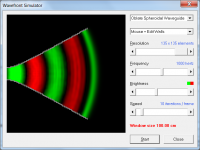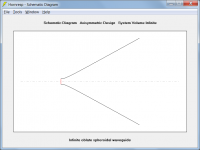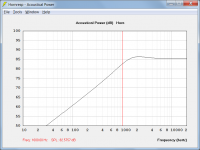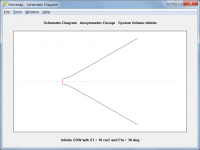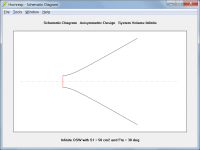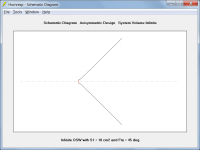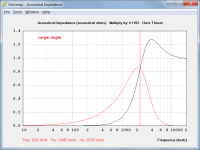I see that it is easier to conceive of waves using a planar wavefront but I don't think it is truly correct to do that.
Of course it is not true and therein lies the fallacy of Webster's Equation.
The problems are compounded by the simple factor we are working with finite length horns and thinking in 1/4 wavelengths. I see no perfect curvature that can ever perfectly cover the bandwidths we are always attempting to work with. A horn will always have to be compromised at one end of the bandwidth or the other, there is no general shape that can satisfy our desires for constant directivity over the entire bandwidth of the device.
This problem was studied in some detail and extremely well done, by a PhD student in Aus. He looked at the waveguide contour parametrically and found that the "best" contour was extremely close to an OS. I applaud this work, but I was also proud that what I had come up with some twenty years earlier was so close to the ideal. I did not have the computing power back when I studied the problem, it was the mid 80's, so analytical was the only option (although even then I did use a computer to solve the analytical equations.) But finite element and the like were limited to just a few hundred nodes back then and that was never going to solve the problem at higher frequencies.
No device in either acoustics or optics has an infinite bandwidth over which it is optimal. In optics this bandwidth is almost never greater than an octave. In Acoustics three to four octaves is possible, which is a remarkable feat.
No device in either acoustics or optics has an infinite bandwidth over which it is optimal. In optics this bandwidth is almost never greater than an octave. In Acoustics three to four octaves is possible, which is a remarkable feat.
I remember those days of having to create programs to do the math. A lot of calculus to create the shapes that we both seemed to conceive of that others had missed. We may have come to our conclusions from opposite ends of the waveguide but it does seem the differences were more minor than major in our efforts. Having to describe 3D cross-sections in x,y,z coordinates before there was any 3D cad didn't help.
Dr. Geddes,
G.R.Putland?
Kindest regards,
M
This problem was studied in some detail and extremely well done, by a PhD student in Aus.
G.R.Putland?
Kindest regards,
M
Hyperbolic Horn History
The following two doctorial dissertations, reflect the early work done on the subject horn at MIT in the 1930’s
The Velocity Potential of an Hyperbolic Horn
by
John Edwin Frehafer (1937)
http://pdf.docrchive.com/pdfs/0e08e1ea02dc4d67b60f880e4c7d3e5f.pdf
The Sound Field and Radiation Impedance of a Hyperbolic Horn
by
Vincent Salmon (1939)
http://dspace.mit.edu/bitstream/handle/1721.1/45994/35167649-MIT.pdf?sequence=2
I may have posted these before in this thread or elsewhere a long time ago.
WHG
The following two doctorial dissertations, reflect the early work done on the subject horn at MIT in the 1930’s
The Velocity Potential of an Hyperbolic Horn
by
John Edwin Frehafer (1937)
http://pdf.docrchive.com/pdfs/0e08e1ea02dc4d67b60f880e4c7d3e5f.pdf
The Sound Field and Radiation Impedance of a Hyperbolic Horn
by
Vincent Salmon (1939)
http://dspace.mit.edu/bitstream/handle/1721.1/45994/35167649-MIT.pdf?sequence=2
I may have posted these before in this thread or elsewhere a long time ago.
WHG
What sets the lower limit on an infinite waveguide with an ideal driver?In Acoustics three to four octaves is possible, which is a remarkable feat.
I have always considered that the actual wave-fronts would always be of a curved surface or more realistically a spherical wave shape that is simply distorted by the shape or containment of the waveguide until it exits the horn if larger than the mouth or forms earlier in the horn when the wavelength is smaller than the mouth diameter.
Attachments
Of course it is not true and therein lies the fallacy of Webster's Equation.
The Webster plane wavefront model does however have its uses. For example, if you wish to model a bass horn, where the wavefront curvature is relatively minor and directivity is not an issue.
Attachments
Quick Answer
The dimensions that are not infinite.
WHG
What sets the lower limit on an infinite waveguide with an ideal driver?
The dimensions that are not infinite.
WHG
Less Quick Answer
The acoustical power output is determined by the throat acoustical impedance of the infinite waveguide.
What sets the lower limit on an infinite waveguide with an ideal driver?
The acoustical power output is determined by the throat acoustical impedance of the infinite waveguide.
Attachments
Dr. Geddes,
G.R.Putland?
Kindest regards,
M
No Putland's work was purely analytical nothing digital. And it was long ago. The work I am referring to was just a few years back. Don't remember the name.
What sets the lower limit on an infinite waveguide with an ideal driver?
This limit is determined by the impedance, as stated, but the impedance is determined by the throat radius and the wall angles. As you can see it is basically a HP filter. A larger throat lowers the frequency and a larger angle increases it.
No Putland's work was purely analytical nothing digital. And it was long ago. The work I am referring to was just a few years back. Don't remember the name.
I think it must be Richard G. Morgan: "Optimisation techniques for horn loaded loudspeakers", PhD in Mech. Eng. Univ. of Adelaide, 2004
Marco
Rick C. Morgans ..
.. I presume. Two ICSV Papers attached. WHG
No Putland's work was purely analytical nothing digital. And it was long ago. The work I am referring to was just a few years back. Don't remember the name.
.. I presume. Two ICSV Papers attached. WHG
Attachments
Last edited:
I think it must be Richard G. Morgan: "Optimisation techniques for horn loaded loudspeakers", PhD in Mech. Eng. Univ. of Adelaide, 2004
Marco
Yeah.
https://www.google.com/url?sa=t&rct.../41350&usg=AFQjCNE61JPWvM92V217xeNY35oC3BGrUQ
I think it must be Richard G. Morgan: "Optimisation techniques for horn loaded loudspeakers", PhD in Mech. Eng. Univ. of Adelaide, 2004
Marco
I would guess that is correct.
A larger throat lowers the frequency and a larger angle increases it.
Attachments
Actually, that is not the thesis that I was talking about. Disappointingly, there is a lot of inaccuracy in that thesis.
Oh!
Interesting.
If you come across the one you had in mind again, I would love to get the reference.
Kind regards,
Marco
- Home
- Loudspeakers
- Multi-Way
- Geddes on Waveguides
